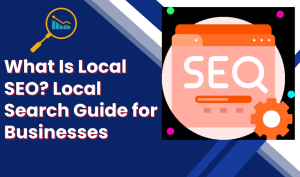Local SEO is one of the most important aspects of online marketing. It’s the process of optimizing your website for local search results. This means making your website content and on-page elements useful and relevant to people looking for information about businesses and services in your area.
Local SEO is the process of optimizing your website for local search results. This involves making sure your website is properly indexed by search engines, and that the content on your website is specifically tailored to the needs and interests of people who live in the area you’re targeting.
Local SEO is the process of making your website rank higher in local search results pages (SERPs) for specific keywords. When people search for a product or service locally, they’re looking for businesses that are close to them. This means that you need to be ranking highly for your target keywords in local search results pages if you want people to find you.
What is Local SEO?
Local SEO is a method of optimizing your website for local search results. This means tweaking your website content and layout to make it more relevant and useful to people who are looking for information about local businesses and services in their specific area. By doing this, you can increase traffic to your website and improve your chances of ranking higher in local search results.
Local SEO is an important part of successful online marketing, and it can help you compete with larger companies that have a much bigger budget. However, it’s not easy to do well at local SEO, and you’ll need to invest time and effort into it if you want to see the benefits. If you’re ready to start working on your site’s local SEO, here are some tips to get started:
1. Research your area – Before you can begin optimization, you need to know what keywords are most relevant to your region. Use Google Trends or other search engine analysis tools to find out which keywords are being used most often by locals looking for information about specific businesses and services. then make sure your website content is focused on providing valuable information on those keywords.
2. Improve site layout – Make sure all of your pages look consistent and organized according to your region’s specific style and layout. For example, you might want to use headings and subheadings on your home page to make it easier for users to navigate.
3. Add local content – Write articles, create videos, or post images that focus on your area of the country or world. This will help you stand out from the competition and attract more local visitors.
Why Is Local SEO Important?
Local SEO is important for a couple of reasons. First, it helps your business be found when potential customers are looking for local businesses. Second, it can help you rank higher in search engine results pages (SERPS) for specific keywords related to your business.
Here’s a more in-depth look at why local SEO is so important:
1) Your Business Can Be Found When Potential Customers Are Looking For Local Businesses
When potential customers are looking for local businesses, they will often use Google and other search engines to find them. This means that if your business is not properly localized, you may not be able to be found by potential customers.
2) You Can Rank Higher In Specific Keyword Searches Related To Your Business
If you have specific keywords that you want to rank for in search engine results pages (SERPs), then localized SEO is essential for achieving this. Local SEO can help you rank higher for these keywords by showing people who are looking for information about your business that you are also relevant and valuable with regard to those keywords.
What are the Different Types of SEO Services?

Local SEO is the process of optimizing a website for local search engine results. It can be broken down into two categories: on-page optimization and off-page optimization. On-page optimization focuses on making sure the website’s content is well-written, relevant, and accessible. Off-page optimization involves setting up links to the website from relevant websites and social media pages.
Local SEO can be time-consuming and require a lot of dedication. However, it can be an effective way to increase visibility for a business and attract new customers. There are a variety of different services available to businesses that want to improve their local SEO ranking, so it’s important to choose the right one for your situation.
Some popular services include Google Adwords Local, LinkConnector, and SEMrush Local Results. It’s important to determine which service will work best for your business before starting any optimizations.
What Are the Steps for Optimizing Your Website for Local SEO?
When you’re optimizing your website for local SEO, there are five steps that you need to take: create an optimized title tag, meta description, H1 headline, images, and content.
The first step is to create an optimized title tag. The title tag is the most important element of your website for local SEO and it’s what will show up in the search engine results pages (SERPs). Make sure that your title tag is keyword rich and includes words that are relevant to your business. For example, if you sell jewelry, make sure your title tag includes words like “jewelry,” “gold,” or “silver.”
Next, you need to create a meta description. This is a short sentence that describes your website in detail and tells potential customers what they can expect when they visit. Make sure that your meta description is keyword rich and includes the keywords that you want to rank for in search engines.
Next, you need to create an H1 headline. This is the most important headline on your website and it needs to be keyword rich as well. Make sure that it’s catchy and describes what people will find when they click on it.
How to Use Google Maps for Local SEO?
Google Maps is a fantastic tool for local SEO. It can help you find businesses near you, pinpoint the best locations for your business, and even see what customers are searching for nearby.
Here are a few tips on how to use Google Maps for local SEO:
1. Start by finding your business location. Open Google Maps and type in your business name or address. You’ll see a map of your area with pins placed where your business is located.
2. Use the pins on the map to zoom in and explore different areas around your business. Zoom in close enough so that you can see individual businesses and streets. Use this information to create localized listings on Google Maps.
3. Add keywords to the pins on the map as you go. This will help you target potential customers who are looking for similar services or products.
4. Use the “Info” button next to each pin to learn more about that location, including reviews from other customers and ratings from Google Maps users (if available).








